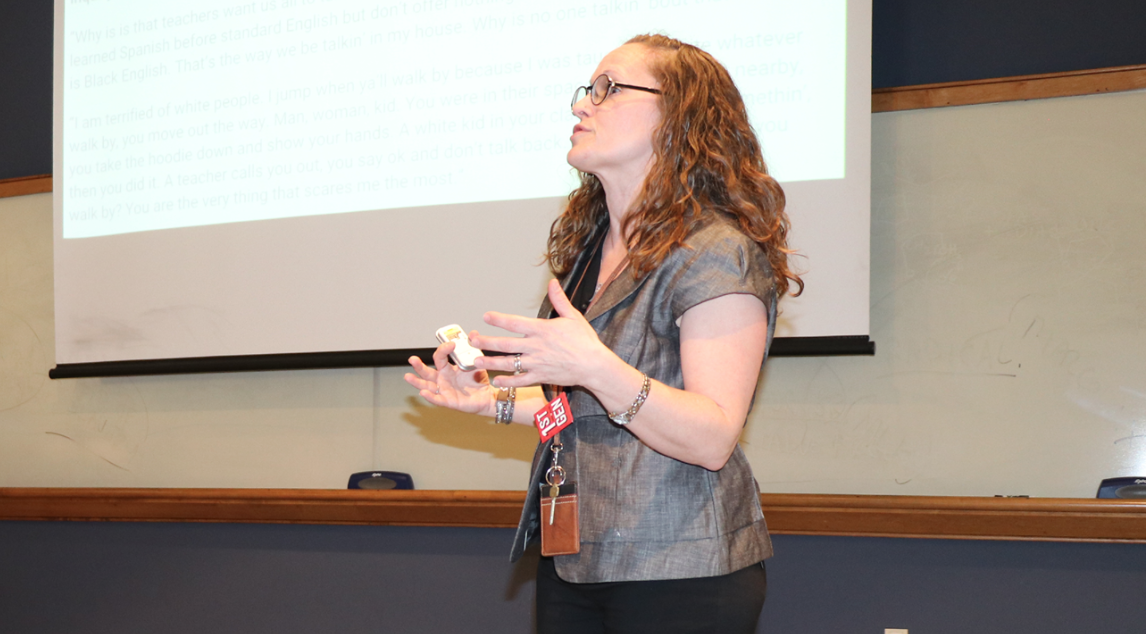
Charlese Freeman
Student Life Editor
Dr. Laura Kieslbach prompted educators to explore different teaching techniques from a cultural perspective.
“When I began teaching in a very urban setting, they [students] looked different, they spoke different, they were different, and I realized right away that I needed to teach different,” she said.
She presented her research on the dynamics of culturally relevant teaching. She kept her audience’s attention with group conversations and activities.
More than 100 people gathered in Beers lecture hall last Wednesday. The crowd was a blend of colleagues and students.
“That’s my professor”, a group of students roared as Kieselbach took her place in front of the crowd.
Dr. Kieselbach research focuses on diversity in literature and culturally responsive pedagogy. The core of her work is based on secondary-education, but the idea of culturally relevant pedagogy is necessary in every academic discipline.
She received her bachelor’s degree from Pennsylvania State University, her master’s from University of Central Florida and her doctoral degree from Northeastern University.
The purpose of culturally relevant teaching is to create a diversity and significance within a curriculum, making education more meaningful for the students.
Growing up in the small town of Forty Fort, Pa, she is the youngest of four siblings and was raised in a Roman Catholic household. She experienced others in her town suffering from poverty as a result of a declining coal industry.
During her presentation, she openly identified herself as a white woman, but she her ability to recognize cultural differences has made her very successful in the classroom.
“Sometimes, who we are is miles away from who our students are, so how do we become a learning community when there is that much difference?” she asked.
Inspired by Chris Emind, author of This is For the White Folks Teaching in the Hood and the Rest of Y’all, she discussed ways to change the environment of a classroom. Quoting Edmin: “let them get turnt up before they get tuned in.”, she adopted music as one of her methods of culturally responsive teaching. She starts her classes with music that students suggest. Kieselbach admitted she was hesitant to play some songs because of the provocative language.
“Do I play that music and then I have to ask: why not? It’s their culture; they chose these songs. I’m going to take five minutes from my class and give it [culture] to them through music. What’s the harm in that?” said Kieselbach.
She noted that the professional standards are changing. The educational shift requires a change in teaching approaches. Instructors need willingness to evolve in order to properly meet students’ needs.
Throughout the presentation Kieselbach popped around the room, talking with faculty and students. The first work sheet she asked her audience to complete was a socio-gram.
This test asked the audience to think about all the people they know and how much they know. The concept being everyone is an expert at something and can teach as well as be taught something. The test highlighted individual patterns regarding knowledge, race and class.
The lack of representation (including authors and subject matter) creates detachment and limits ability to receive the curriculum. Understanding that students in a classroom have a culture of their own is the only way to inspire change within a classroom.
The next activity that participates were asked to complete was a mindset test. The test assessed rather an individual was classified as having a fixed mindset, a growth mindset or somewhere in between.
After a short two minutes, Kieselbach asked her audience based on their results what mindset where they classified under? Most people raised their hands as someone with strong growth mindset.
“How many people have a fixed mindset?” then asked the following question “how many people don’t want to answer that question?” she asked.
Most people like to think they are open minded and accepting of change, but in reality even the most open minded individuals have fixed ideas. Fixed perceptions are acquired through life experience and can be misleading.
Educational blind-spots can often block change in the classroom, and many are unaware their own ignorance and perceptions. Identifying areas that require improvement can make a relatable learning environment. Student capitals are constantly growing. Educators can contribute to the diversity student capitals. Dr. Kieselbach said one way for everyone to grow is by sharing capitals.
“I moved to FL where I could pursue my goal to teach and make a real difference. This is where I fell in love with my craft and with the students who don’t “open up” naturally,” said Kieselbach, in an email. “Those struggles I mentioned haunted me in high school and no one knew, so I have made it my business to know about my students and work to make even a small difference in their lives.”
Email Charlese at:
cfreeman2@live.esu.edu

